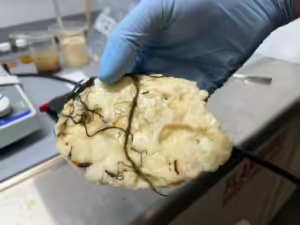Odd ‘blobs’ are washing up on the shores of Newfoundland.

Canadian authorities are looking into the white blobs that have been washing up on Newfoundland beaches lately. The unusual substance was first reported by beachcombers in early September at the southern point of the Canadian province.
Online beachcombers’ group started posting pictures of the material, which led to conjecture that it might be mold or fungus, palm oil, paraffin wax, or even ambergris, a rare and precious substance made by whales and used in perfumery. On the southeast coast of Newfoundland, the blobs were observed along the coasts of Placentia Bay.
One day last month, he came upon the mysterious lumps and at first thought they were Styrofoam. He claimed to have discovered “hundreds and hundreds of globs – big globs, little globs” since then, the majority of which were roughly 6 inches (15 cm) in diameter.
However, upon reporting the results to the Canadian Coast Guard, Mr. Tobin was informed that the substance’s base was ruled out.
The mystery of blobs washing up on Canada’s shores has been solved.

As images of the white material surfaced online this fall after being observed along the shores of Placentia Bay, on the southeast coast of Newfoundland, Canadian authorities launched an inquiry.
Some speculated on the internet that the substance, which some people compared to dough, might have been wax, mold, or fungus.
However, after analyzing the material, Chris Kozak, a chemical professor at Memorial University, found that it was artificial and made of synthetic rubber. Still, the origin of the blobs is unknown. Professor Kozak told CBC that he informed the Canadian government of his findings and that their experts have since begun carrying out their experiments.
Although Environment Canada acknowledged Prof. Kozak’s study, it stated that it “is not in a position to validate or substantiate theories or findings of others, nor does it share hypotheses on the identity or origins of a substance undergoing testing.”
The substance appeared nearly doughy, “like someone had tried to bake bread and done a lousy job,” and had an odor reminiscent of vegetable oil, according to Stan Tobin, a resident of Ship Cove, a small community on the bay, who spoke to the BBC.
Since then, he has discovered “hundreds and hundreds of globs – big globs, little globs” with the majority being roughly 6 inches across. Prof. Kozak told the Guardian newspaper that “substantial amounts” of the material may lie on the Atlantic Ocean’s bottom and that marine life may mistake it for nutrition.
